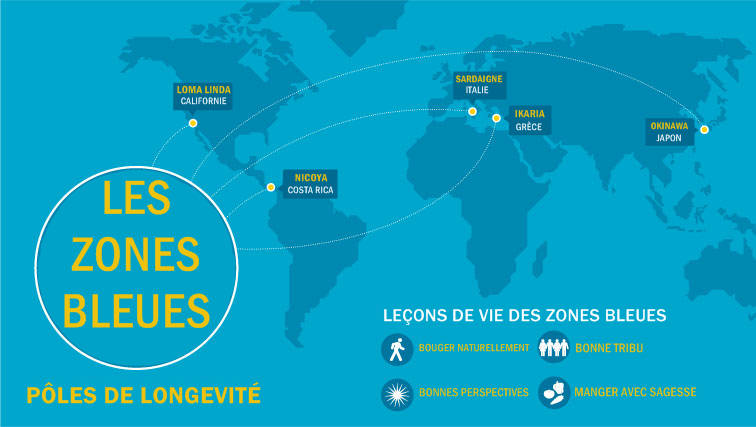It was in 2000 that an Italian academic and a Belgian demographer discovered, in the mountains of the Nuoro province in Sardinia, the largest known concentration of centenarian men in the world. They marked this area on the map with a blue pen, which gave it its name of blue zone.

What are the 5 blue zones?
A blue zone is defined as “A territory that has a significantly higher than average number of very old people, particularly centenarians, in good health.”
In 2017, 5 zones were identified in the world:
the Nuoro province in Sardinia.
First to be discovered, this very mountainous province is part of one of the 3 blue zones in Sardinia: Ogliastra, Barbagia, and South Sardinia.
the island of Ikaria in Greece.
Located to the east of the Aegean Sea, it is almost entirely covered by a mountain, whose peak reaches 1040m.
the island of Okinawa in Japan.
The southernmost island of the Japanese archipelago, it is nicknamed the “Japanese Hawaii,” and enjoys a sub-tropical marine climate.
the Nicoya Peninsula in Costa Rica.
Quite mountainous, this peninsula is part of the driest province in the country.
Loma Linda in California.
The vast majority of its inhabitants belong to the Seventh-day Adventist community and are very devout.
What are the characteristics of the blue zones?
All located in the northern hemisphere, the blue zones and their populations are quite different from each other in terms of geography, culture, religion, etc. Yet, common points emerge.
Thanks to their sunny, fairly warm climate, and their more or less mountainous terrain, these oases benefit from a healthy and preserved environment in terms of ecology, with good air and water quality.
This terrain, at least hilly, has created an invisible boundary with the rest of the world. A sort of cocoon, protecting family life and community life. Moreover, there is great solidarity among the inhabitants.
Another common point among the inhabitants of the blue zones is their lifestyle, in harmony with nature, its rhythms, and far from the stress of big cities.
Agro-pastoralism is predominantly practiced. Combined with the more or less rugged terrain, it helps provide a fairly sustained physical activity for the population
Why is longevity greater in blue zones?
The inhabitants of blue zones live longer, but also in better health.
Genetics has been mentioned as a contributing factor, but it is not enough to explain such a phenomenon.
It appears that social and family interactions play a major role in this longevity. The elderly are well-surrounded and respected by the younger generations. In most blue zones, like in Japan, several generations live under the same roof. This has a stimulating effect and helps combat depression.
Physical activity holds a significant place. Regardless of their age, the inhabitants tend to their gardens, walk, and ride bicycles.
A healthy environment, far from the stress of the city, is very beneficial. The Nicoya Peninsula and its philosophy of "Pura Vida," meaning "well-being is pleasure," is a perfect example with 13% of its inhabitants over 90 years old.
But all of this would be nothing if this lifestyle were not accompanied by a healthy diet. Indeed, they all consume local products, far from the food industry.
What is the diet of the inhabitants of blue zones?
Depending on the blue zones, different diets are found. For example, the inhabitants of Ikaria eat fish, while those of Nuoro consume cured meats.
There is still one common point: their diet.
It is primarily plant-based and consists of vegetables, fruits, and whole grains. Animal products (meat, fish, cheese) are consumed in small quantities or reserved for celebrations. Except in Loma Linda, where the population is vegetarian.
Then, each region adapts to its environment:
The Okinawans eat tofu at every meal, seaweed, or fruits like noni, which is very high in vitamin C.
Costa Ricans consume corn tortillas, rich in vitamin B3, vegetables, and beans high in fiber.
The Ikarians follow the Mediterranean diet: vegetables, fish, olive oil, and whole foods.
The Sardinians favor dairy products (made from sheep and goat milk), which they produce themselves.
3 lessons to improve longevity:
Even though it is quite difficult to have the same lifestyle as an inhabitant of a blue zone, we can still change some habits to improve our longevity.
First of all, it is necessary to change your diet in order to rediscover the pleasure of "eating better". To do this, we will prioritize organic products grown locally, reduce our intake of animal proteins, and eliminate industrial dishes and other refined products as much as possible.
Next, in our societies where everything must be done "in a hurry," we will need to take the time to relearn how to move. Physical activity is beneficial for cardio-respiratory health, but also for mental well-being. And if we are fortunate enough to practice it outside an urban environment, we can reconnect with nature and breathe in some of that fresh air that benefits centenarians so well.
Finally, we need to reconnect with others, whether in a family, friendly, or associative context. This helps to open our minds, create a whole support network in case of need, and reduce stress.
Sophie Ely




